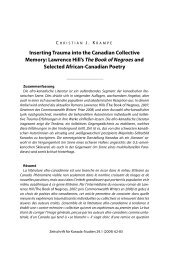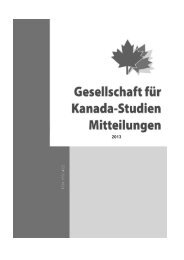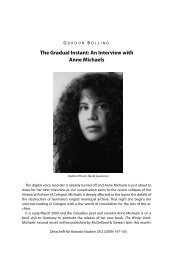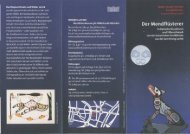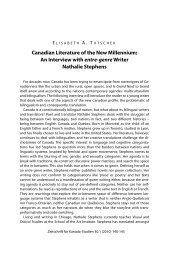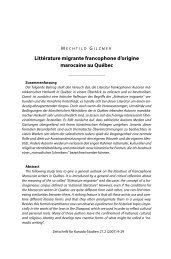The Beginnings of Contemporary Aboriginal Literature in Canada ...
The Beginnings of Contemporary Aboriginal Literature in Canada ...
The Beginnings of Contemporary Aboriginal Literature in Canada ...
Create successful ePaper yourself
Turn your PDF publications into a flip-book with our unique Google optimized e-Paper software.
<strong>The</strong> <strong>Beg<strong>in</strong>n<strong>in</strong>gs</strong> <strong>of</strong> <strong>Contemporary</strong> <strong>Aborig<strong>in</strong>al</strong> <strong>Literature</strong> <strong>in</strong> <strong>Canada</strong> 1967-1972: Part Two 75<br />
porary poetry by modern day Inuit poets are arranged thematically, and they are<br />
credited to particular Inuit cultures (e.g. Copper, Thule) or to the <strong>in</strong>dividual authors<br />
whose places <strong>of</strong> residence are also given. <strong>The</strong> editor expla<strong>in</strong>s that his collection was<br />
spurred by his “<strong>in</strong>terest <strong>in</strong> the literature <strong>of</strong> Indigenous people” and that <strong>in</strong> the course<br />
<strong>of</strong> his research he “became <strong>in</strong>trigued by the quality <strong>of</strong> much <strong>of</strong> the Eskimo poetry<br />
[he] came across. But to [his] surprise there was not one collection exclusively devoted<br />
to present<strong>in</strong>g a cross section <strong>of</strong> Eskimo poetry” (Lewis 1971, 6). In his respectful<br />
<strong>in</strong>troduction, “Life as it Was”, Edmund Carpenter expla<strong>in</strong>s that <strong>in</strong> Inuttitut “to<br />
make poetry” is the same word as “to breathe” (cf. Carpenter 1971, 11). Additional<br />
ethnographic background <strong>in</strong>formation demonstrates the editor’s scholarship <strong>in</strong><br />
l<strong>in</strong>guistics. <strong>The</strong> book shows that, at least <strong>in</strong> the United States, there was a genu<strong>in</strong>e<br />
non-<strong>Aborig<strong>in</strong>al</strong> <strong>in</strong>terest <strong>in</strong> contemporary poetry by Indigenous authors, and that<br />
there were Inuit poets <strong>in</strong> the North whose works warranted publication.<br />
Sara<strong>in</strong> Stump (1945-1974) was an outstand<strong>in</strong>gly gifted visual artist and poet <strong>of</strong><br />
Shoshone background on his father’s side and <strong>of</strong> European orig<strong>in</strong> on his mother’s.<br />
<strong>The</strong> untitled <strong>in</strong>troduction to his most remarkable book <strong>of</strong> “ethnic poem-draw<strong>in</strong>gs”,<br />
<strong>The</strong>re Is My People Sleep<strong>in</strong>g, conta<strong>in</strong>s excerpts from his first letter to his publisher, <strong>in</strong><br />
which he touches upon his fasc<strong>in</strong>ation with, and broad knowledge <strong>of</strong>, contemporary<br />
Modern Native American Art – Allan Houser, Qu<strong>in</strong>cy Tahoma, Santa Fe Indian<br />
School – and traditional European art – the fasc<strong>in</strong>at<strong>in</strong>g and mysterious 15 th -century<br />
Dutch “surrealist” pa<strong>in</strong>ter Hieronymus Bosch is mentioned. In his letter Stump then<br />
expla<strong>in</strong>s that he wants to make his home <strong>in</strong> <strong>Canada</strong>, and he expresses a desire to<br />
meet George Clutesi, who “is the first <strong>of</strong> the Indians far away I feel like go<strong>in</strong>g to see”<br />
(Stump 1970, no pag<strong>in</strong>ation throughout). At first sight, Sara<strong>in</strong> Stump’s <strong>The</strong>re is My<br />
People Sleep<strong>in</strong>g seems to <strong>in</strong>vert the process <strong>of</strong> illustrat<strong>in</strong>g a text, because his draw<strong>in</strong>gs<br />
tell stories <strong>of</strong> which the few pr<strong>in</strong>ted words <strong>of</strong> his poems – haiku-like – reveal<br />
only a skeleton. But there is more to it. <strong>The</strong> book <strong>in</strong> its entirety is a multi-media work<br />
<strong>of</strong> art, where the <strong>in</strong>dividual elements aesthetically and thematically support each<br />
other to enhance the book’s emotional impact.<br />
<strong>The</strong> beautiful hardcover volume <strong>in</strong> landscape format comprises 160 (my count)<br />
unnumbered pages. All texts are pr<strong>in</strong>ted <strong>in</strong> capital letters, so no upper- or lowercase<br />
changes <strong>in</strong>terfere, but each word stands by itself as equally important, a technique<br />
rem<strong>in</strong>iscent <strong>of</strong> Gertrude Ste<strong>in</strong>’s poetry. All draw<strong>in</strong>gs by the poet-artist, either<br />
<strong>in</strong> <strong>in</strong>k and brush or <strong>in</strong> pencil, are pr<strong>in</strong>ted black on white. <strong>The</strong>re is a total <strong>of</strong> ten poems,<br />
all <strong>of</strong> them short, which are scattered throughout the book like head<strong>in</strong>gs beg<strong>in</strong>n<strong>in</strong>g<br />
new chapters. <strong>The</strong>se ten <strong>in</strong>dividual poems are each pr<strong>in</strong>ted <strong>in</strong> white capital<br />
letters on a red ochre background on an uneven numbered page on the right. <strong>The</strong><br />
fac<strong>in</strong>g page to the left is left blank, so the short poems stand out prom<strong>in</strong>ently by<br />
themselves. <strong>The</strong>y are then followed by white pages with black pr<strong>in</strong>t. With the turn<strong>in</strong>g<br />
<strong>of</strong> each page the reader-viewer opens a new tableau, where text and image<br />
enhance each other and challenge the visitor to connect the two media and th<strong>in</strong>k<br />
about how they are connected. On each <strong>of</strong> the left pages the reader f<strong>in</strong>ds one <strong>in</strong>di-



